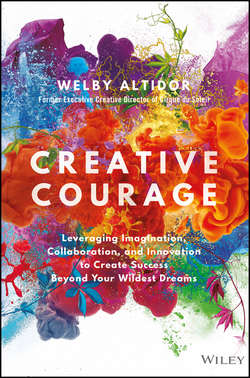Читать книгу Creative Courage - Altidor Welby - Страница 13
На сайте Литреса книга снята с продажи.
INTRODUCTION
What Is Creative Courage?
ОглавлениеI draw inspiration from different definitions and from my personal practice to define in my own words what creativity and courage mean:
1. Creativity: Leveraging original ideas or unrelated ideas or remixing ideas to produce something artful, skillful, or masterful that questions, persuades, or moves. It's imagination writing a sentence with an invented grammar. Creativity is not limited to art; rather, being alive itself is being potentially creative, and so it is an expression of life.
2. Courage: Deciding to move forward toward the unknown, the uncertain or the certain, despite being afraid.
Small children often have an advantage over adults when it comes to being able to practice creative courage because they are still in touch with their “explorer of the unknown” side. They constantly invent new solutions to tough problems, and since they can't read yet, instruction booklets are pointless.
Developing the mind-set of creative courage when things were hard at work gave me confidence professionally. I was influenced by a set of values and experiences like grit, confidence, perseverance, relentlessness, compassion, a sense of survival, desperation, discouragement, crippling doubts, detachment, and resilience. These words form a background behind my thinking about creative courage and its practice.
Practicing creative courage means developing a mental posture that helps us move forward in the world, despite a fear of rejection and failure. It suggests that we can work with the objective of bringing value to ourselves and others. Our goal when we practice creative courage is to provoke important questions, offer valuable answers, support insight, and see every emotion as noble.
It suggests a graceful movement forward, knowing that we can always improve our ability to be more in touch with our skillfulness. It proposes a path to develop our ability to share our creative courage with others. And it offers an open door to embrace what's artful in us. We can find the paths in us that point toward mastery and even virtuosity, no matter who we are and what we do. Practicing creative courage proposes routes to move past the fear of failure. There we find a new path toward the joy of bringing something essential to our life and that of others. In concrete terms, it means learning to passionately love discovering through the unknown. It means facing head-on a difficult challenge, a problem that at the moment seems impossible to resolve, even embracing a situation where most would doubt you or your group could succeed.
Relevance becomes the ultimate currency, a new, unconventional factor that I like to call our high line– expanding our conventional preoccupations for the bottom line of our organization. So I argue here that beyond the traditional thinking we have about profit and balance sheet (bottom line), we must integrate in our aspiration a high line thinking about relevance, meaning, and resonance for the people that we create for and that ultimately benefit from our work.
Finally, creative courage refers to that voice inside you that moves past the accusatory, contemptuous whisper, “Who do you think you are?” and tries to create something beautiful nonetheless or something meaningful, even if the risk of rejection or failure is great. Simply saying “Forward, nonetheless, forward despite it all, forward despite the fear” triggers a momentum of its own and builds inside you a mind-set that can transform the way you lead your life, the teams you support, the projects you craft, and the organizations that you belong to. As a mind-set, it changes our perspective on solving unusual and unconventional problems. It makes us accept and embrace the fact that many of our relevant and crucial challenges have no instruction booklet. It refers to an inner game of creativity, a mentality to be developed over time yet instantly accessible. It is not only a set of techniques and tips. It suggests that at the heart of management, leadership, and business, there is a profound call and a yearning for an approach that's artful, heart-full, and truly supports creativity, innovation, and growth.
Although the practice of creative courage and the mind-set behind it can help us find solutions to tough, nearly impossible problems to solve, the more potent power of creative courage can help us make sense of our differences, transforming them into a powerful advantage for business, leadership, and innovation. It can trigger a belief in our ability to find solutions to problems despite the absence of an instruction manual or ready-made answers. Practicing our leadership with the framework it proposes can support our efforts to bridge the gap over our complex diversity, leveraging our imagination to find the gold in what makes us disparate yet connected.
In this way, we can dramatically improve our skills at integrating diverse groups of people (diverse in terms of age, gender, talents, abilities, geography, backgrounds, disciplines, beliefs, and aspirations, for example) in the context of dissimilar and complex sets of challenges. We end up growing when we tackle projects that can influence the world positively in small and big ways. Practicing creative courage means calling for a new form of artistry at work – an artistry that's asking us to integrate elements, knowledge, and practices that we already know to help do visionary work. Finally, this practice will inspire us to integrate the past and the present of our business and work more constructively than we've done previously.
